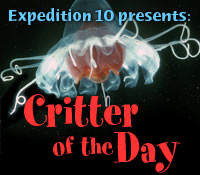|
Try the interactive puzzle »
February 24, 2006 by Kate Madin Inside the Gould’s labs is barely controlled chaos. Researchers step briskly from the wet lab to the hydro lab, carrying samples back and forth, trying not to collide. The door from the wet lab to the aft deck slams open, someone in foul-weather gear hands in bucket after bucket of sloshing plankton and water, and the chaos intensifies. We have to sort, classify, measure, and preserve nine samples from plankton tows, then repeat the process every four hours, for 48 hours straight. The team is still processing the first batch when the next nine samples arrive in the wet lab. The group is doing a timed net tow using a plankton net system: a heavy metal frame, elaborate mechanical and electrical parts, and 108 yards (98 meters) of netting make up the nine connected nets of MOCNESS (Multiple Opening and Closing Net Environmental System Sampler). They collect plankton at different water depths, during one tow, without mixing them. Erich Horgan builds and runs these computer-controlled nets. Erich, Marine Technicians Jamee and Peter, and two teams of researchers, handle the nets on the aft deck—even on a rocking ship in the dark. Dr. Jun Nishikawa is interested in salp populations. A marine biologist from the University of Tokyo, he studies salps near Japan in the Pacific Ocean, and in the Southern Ocean, including the species that lives here, Salpa thompsoni. He is especially interested in the population structure—the sizes and ages of animals present at one time. Jun wants to find out where the salps are during day and night, what sizes and ages are present, and what they are eating. These salps do what is called “vertical migration”—they swim upwards in the ocean at night, and back down deep every day. These 3-inch-long (8-centimeter) soft, slow salps swim up to 500 meters (1,500 feet) each way per day. The tows will help him understand what the salps are doing. “The salps here are at different depths than my data show from eastern Antarctica,” he said, “and the water is warmer at the surface. Maybe the warm water here is keeping the population deeper in the water.” Somebody grabs a bucket and pours the plankton into a sieve. Someone else measures its volume, dumps it into a numbered pan, and passes it to the next table. Lena Von Harbou runs in from the next room to pick out some choice salps, reaching into the pan with sharp forceps and running back into the other lab. It’s a choreographed dance. “Did Lena get her salps?” asks Pat. “Does anyone know what this animal is?” Brenna wants to know. “Do you want me to record salp lengths?” Sandy Williams says to Jun, who is beginning to measure the many, many salps in the sample.
|
|||||||||||||||||||||||||||||||||||||||||||||||||||||||||||||||||||||||||||||||||||||||||||||
Mailing List | Feedback | Glossary | For Teachers | About Us | Contact
© 2010 Dive and Discover™. Dive and Discover™ is a registered trademark of Woods
Hole Oceanographic Institution






